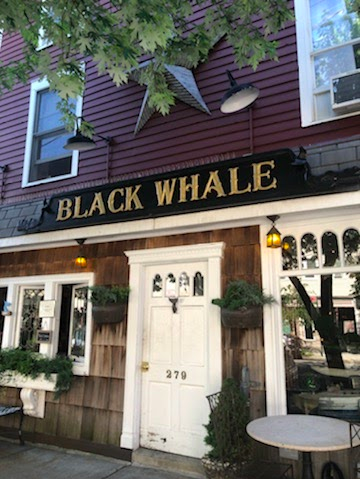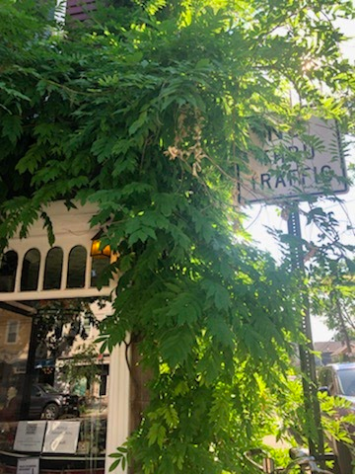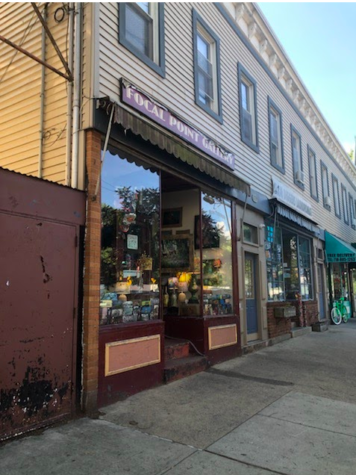The Forgotten Bohemians of City Island
What became of the bohemian population in City Island, the Bronx?

Here is the front of the Black Whale, an iconic City Island restaurant.
City Island is an island neighborhood of New York City located just off the coast of the East Bronx. Today, the insular community is home to seafood restaurants, marinas, and scenic views of the Long Island Sound and Manhattan skyline, but it was only fairly recently a sizable haven for artists and hippies.
For many years, City Island was dominated by the boatbuilding industry: sailmakers on the island crafted sails that won World Cups and fiberglass production was ubiquitous. In turn, stores catering to these businesses were common. Most City Islanders were employed within the neighborhood because of the many sailing-related jobs available.
But in the latter half of the twentieth century, this dominance began to fade, and the businesses centered around the industry closed up. This was an unfortunate part of City Island history, but it would ultimately serve as a catalyst for a bohemian community to arrive.
The Black Whale was the foundational element for the creation of the City Island bohemian population. It has continued its operations as a popular restaurant, although self-proclaimed bohemian Richie DePierro opened it in 1961 as a dessert shop. The Black Whale also frequently sponsored events such as poetry readings and plays in the 1960s, creating a mood reminiscent of Greenwich Village happenings.
This atmosphere attracted other bohemians to City Island throughout the 1960s and 1970s, filling the empty storefronts left in the wake of the shipping industry with new artistic and artisinal businesses, such as Creative Mud Pottery, Thirsty Boots Leather, and the Silver Fox antique store. Mooncurser was another antique shop owned by a man named Roger Roberge, which became world-famous for its record collection that was sought after by visitors from as far as Japan. The various bohemians banded together to form an organization called the Renaissance Association, and they started an annual craft fair, which attracted Ron Terner, the owner of still-operating Focal Point Gallery, to City Island.

In 1982, a new bohemian moved to town, King Vito. Vito was a shrewd businessman who observed the success of the Black Whale restaurant, and he decided to open a shop of his own. He called it the Hippie’s Place, and like the Black Whale, he sold candies and desserts.
Vito was very clever as a businessman. Before his dessert shop, he had invented a vacuum technology, the patent of which he ultimately sold to Disney. While running the Hippie’s Place, he employed various marketing schemes in order to increase the perceived popularity of his store.
Vito claimed to be running the Hippie’s Place with the intention of earning enough money to refurbish his boat, Freedom. But the project was short-lived, because he was eventually forced to leave City Island and relocate to Sheepshead Bay for unknown reasons; some speculate that the Italian mafia played a role in his departure.

With increased costs of living and broad lifestyle changes, the bohemian culture of City Island has mostly disappeared. But some elements of it still remain. The Black Whale and the Focal Point Gallery are still operating. The annual craft fair has continued to the present-day. And the unique unity and closeness of City Island that the bohemians found attractive and helped to further build has also stayed constant. This, above all, is what many City Islanders recall of the time, and something that they are glad has remained a constant to this day.
With increased costs of living and broad lifestyle changes, the bohemian culture of City Island has mostly disappeared. But some elements of it still remain. The Black Whale and the Focal Point Gallery are still operating. The annual craft fair has continued to the present-day. And the unique unity and closeness of City Island that the bohemians found attractive and helped to further build has also stayed constant. This, above all, is what many City Islanders recall of the time, and something that they are glad has remained a constant to this day.
Johanna Doyle is the Senior Facebook Editor of The Science Survey. She finds both journalistic writing and photography to be appealing because they capture...
Johannah Doyle is the Junior 'Science Survey' FaceBook Editor and also a Staff Reporter for 'The Science Survey.' She finds journalistic writing and photography...
